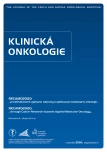Building Mass Spectrometry Spectral Libraries of Human Cancer Cell Lines
Authors:
J. Faktor; P. Bouchal
Authors‘ workplace:
Regionální centrum aplikované molekulární onkologie, Masarykův onkologický ústav, Brno
Published in:
Klin Onkol 2016; 29(Supplementum 4): 54-58
Category:
Original Articles
doi:
https://doi.org/10.14735/amko20164S54
Overview
Background:
Cancer research often focuses on protein quantification in model cancer cell lines and cancer tissues. SWATH (sequential windowed acquisition of all theoretical fragment ion spectra), the state of the art method, enables the quantification of all proteins included in spectral library. Spectral library contains fragmentation patterns of each detectable protein in a sample. Thorough spectral library preparation will improve quantitation of low abundant proteins which usually play an important role in cancer.
Aim:
Our research is focused on the optimization of spectral library preparation aimed at maximizing the number of identified proteins in MCF-7 breast cancer cell line. First, we optimized the sample preparation prior entering the mass spectrometer. We examined the effects of lysis buffer composition, peptide dissolution protocol and the material of sample vial on the number of proteins identified in spectral library. Next, we optimized mass spectrometry (MS) method for spectral library data acquisition.
Conclusion:
Our thorough optimized protocol for spectral library building enabled the identification of 1,653 proteins (FDR < 1%) in 1 µg of MCF-7 lysate. This work contributed to the enhancement of protein coverage in SWATH digital biobanks which enable quantification of arbitrary protein from physically unavailable samples. In future, high quality spectral libraries could play a key role in preparing of patient proteome digital fingerprints.
Key words:
biomarker – mass spectrometry – proteomics – digital biobanking – SWATH – protein quantification
This work was supported by the project MEYS – NPS I – LO1413.
The authors declare they have no potential conflicts of interest concerning drugs, products, or services used in the study.
The Editorial Board declares that the manuscript met the ICMJE recommendation for biomedical papers.
Submitted:
7. 5. 2016
Accepted:
9. 6. 2016
Sources
1. Torre LA, Bray F, Siegel RL et al. Global cancer statistics, 2012. CA Cancer J Clin 2015; 65 (2): 87–108. doi: 10.3322/caac.21262.
2. Weigelt B, Peterse JL, van’t Veer LJ. Breast cancer metastasis: markers and models. Nat Rev Cancer 2005; 5 (8): 591–602.
3. Cho WC, Cheng CH. Oncoproteomics: current trends and future perspectives. Expert Rev Proteomics 2007; 4 (3): 401–410.
4. Gillet LC, Navarro P, Tate S et al. Targeted data extraction of the MS/MS spectra generated by data-independent acquisition: a new concept for consistent and accurate proteome analysis. Mol Cell Proteomics 2012; 11 (6): O111.016717. doi: 10.1074/mcp.O111.016717.
5. Faktor J, Michalova E, Bouchal P. pSRM, SWATH and HRM – targeted proteomics approaches on TripleTOF 5600+ mass spectrometer and their applications in oncology research. Klin Onkol 2014; 27 (Suppl 1): S110–S115. doi: 10.14735/amko20141S110.
6. Schubert OT, Gillet LC, Collins BC et al. Building high-quality assay libraries for targeted analysis of SWATH MS data. Nat Protoc 2015; 10 (3): 426–441. doi: 10.1038/nprot.2015.015.
7. Pernikářová V, Sedláček V, Potěšil D et al. Proteomic responses to a methyl viologen-induced oxidative stress in the wild type and FerB mutant strains of Paracoccus denitrificans. J Proteomics 2015; 125: 68–75. doi: 10.1016/j.jprot.2015.05.002.
8. ftp.uniprot.org [homepage on the Internet]. European Bioinformatics Institute (EBI), United Kingdom, c2002–2015 [updated 2015 March 14; cited June 9]. Available from: ftp://ftp.uniprot.org/pub/databases/uniprot/previous_releases/release-2013_09/.
9. Gundry RL, White MY, Murray CI et al. Preparation of proteins and peptides for mass spectrometry analysis in a bottom-up proteomics workflow. Curr Protoc Mol Biol 2009; Chapter 10: Unit 10.25. doi: 10.1002/0471142727.mb1025s88.
10. Wiśniewski JR, Zougman A, Nagaraj N et al. Universal sample preparation method for proteome analysis. Nat Methods 2009; 6 (5): 359–362. doi: 10.1038/nmeth. 1322.
11. Pellerin D, Gagnon H, Dubé J et al. Amicon-adapted enhanced FASP: an in-solution digestion-based alternative sample preparation method to FASP. F1000Research 2015; 4: 140. doi: 10.12688/f1000research.6529.1.
12. Peterson A, Hohmann L, Huang L et al. Analysis of RP-HPLC loading conditions for maximizing peptide identifications in shotgun proteomics. J Proteome Res 2009; 8 (8): 4161–4168. doi: 10.1021/pr9001417.
13. Duncan MR, Lee JM, Warchol MP. Influence of surfactants upon protein/peptide adsorption to glass and polypropylene. Int J Pharm 1995; 120 (2): 179–188.
14. Stejskal K, Potěšil D, Zdráhal Z. Suppression of peptide sample losses in autosampler vials. J Proteome Res 2013; 12 (6): 3057–3062. doi: 10.1021/pr400183v.
15. UniProt.org [homepage on the Internet]. European Bioinformatics Institute (EBI), United Kingdom, c2002–2015 [updated 2015 March 14; cited 2016 Aug 2]. Available from: http://www.uniprot.org/uniprot/query=*&fil=reviewed%3Ayes+AND+organism%3A%22Homo+sapiens+%28Human%29+%5B9606%5D %22.
Labels
Paediatric clinical oncology Surgery Clinical oncologyArticle was published in
Clinical Oncology

2016 Issue Supplementum 4
Most read in this issue
- The Role of PD-1/PD-L1 Signaling Pathway in Antitumor Immune Response
- Non-Small Cell Lung Cancer – from Immunobiology to Immunotherapy
- Cancer Cells as Dynamic System – Molecular and Phenotypic Changes During Tumor Formation, Progression and Dissemination
- Novel Approaches in DNA Methylation Studies – MS-HRM Analysis and Electrochemistry
